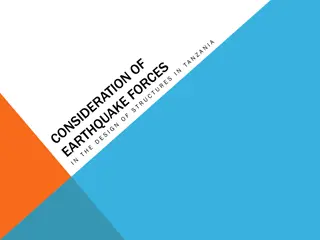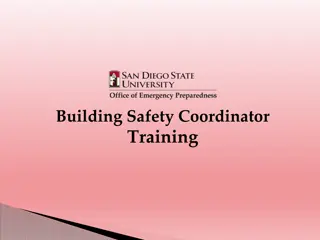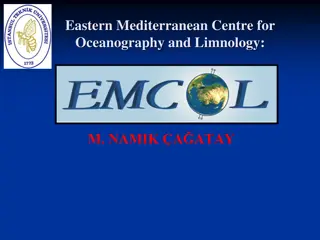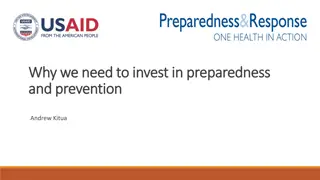Internal Disaster Preparedness in Berkeley: Basic Guidelines
Explore the basics of disaster preparedness in Berkeley, covering topics such as different types of disasters, key elements to consider, common hazards in the area, and ways to mitigate risks. Discover the importance of community preparedness and the local hazard mitigation plan for Berkeley. Be inf
5 views • 48 slides
Urgent Support Needed: Nepal Earthquake Relief Efforts
A devastating 7.8 magnitude earthquake hit Nepal, causing widespread damage and leaving 2.8 million people homeless. Families are desperate for shelter as monsoon rains approach. Habitat is mobilizing engineers to assess damage, provide emergency shelter kits, and support long-term rebuilding effort
2 views • 16 slides
Earthquake Safety and Design Considerations for Building Structures
Earthquake forces can lead to structural failure in buildings, posing a risk to lives and properties. Proper planning, reinforcement, and design elements such as bracing walls and tied members are essential for ensuring safety against earthquake forces. Additionally, consideration of soil type, qual
1 views • 22 slides
Integrated Preparedness Planning Workshop Overview
The Integrated Preparedness Planning Workshop provides a comprehensive approach to documenting preparedness priorities and activities for organizations or jurisdictions. By utilizing the Integrated Preparedness Cycle, efficiency in utilizing resources, time, and funding is maximized, contributing to
0 views • 35 slides
Airport Emergency Preparedness: Essential Guidelines for Managers and Sponsors
Learn the critical aspects of Airport Emergency Plans (AEPs) to ensure the safety and preparedness of airports in the face of emergencies and incidents. Understand the purpose, development process, and key roles involved in AEPs. Discover the importance of differentiating between accidents and incid
0 views • 34 slides
Comprehensive Building Safety and Emergency Preparedness Training
Enhance your safety preparedness with Building Safety Coordinator Training, Emergency Preparedness resources, Communication Resources, Fire Safety procedures, and Earthquake Safety measures. Learn about fire extinguisher use, fire response procedures, earthquake safety considerations, and the seven
1 views • 30 slides
Integrated Preparedness Planning Workshop Overview
The Integrated Preparedness Planning Workshop provides a comprehensive approach for [jurisdiction/organization] to document preparedness priorities and activities. By utilizing the Integrated Preparedness Cycle, efficiency in resource allocation and enhancement of capabilities are prioritized, ensur
0 views • 35 slides
Emergency Preparedness and Safety Drills at Wilson School
Wilson School emphasizes the importance of emergency preparedness and safety drills to ensure the well-being of students. Various drills, including fire, earthquake, lockdown, and team response, are conducted to practice necessary actions in case of emergencies. Fire drills, for instance, are crucia
0 views • 19 slides
Emergency Operations Plan (EOP) Review and Compliance Overview
This comprehensive review covers the objectives of the Emergency Operations Plan (EOP) including healthcare preparedness, CMS Emergency Preparedness Rule, and accreditation requirements. It discusses key aspects to remember when organizing an EOP manual and highlights the impact of CMS compliance on
0 views • 32 slides
Lessons Learned from Papua New Guinea's 2015-16 Drought in Dealing with the 2018 Earthquake
Exploring the correlation between the 2015-16 drought and the 2018 earthquake in Papua New Guinea offers valuable insights into disaster management strategies. Comparisons in impact, response, and long-term consequences highlight the importance of proactive measures and effective coordination in mit
0 views • 15 slides
Winter Preparedness Training for Strategic Leadership in Escalation Situations
The Winter Preparedness Training focuses on preparing executive leads and on-call managers to provide strategic leadership during extreme periods of escalation. The training covers roles and responsibilities, strengths and weaknesses, escalation processes, teleconference chairing skills, partner col
0 views • 20 slides
Active Shooter Preparedness Training Overview
This presentation provides essential information on active shooter preparedness, including organizational readiness, response strategies, and post-incident actions. It emphasizes the importance of having an emergency action plan, conducting training exercises, recognizing warning signs of workplace
0 views • 29 slides
The Role of Concrete in Earthquake-Resistant Buildings
Discover how concrete enhances earthquake resilience in buildings. Learn key design features that make structures safer during seismic events.\n
6 views • 7 slides
Understanding Seismic Source Parameters in Earthquake Dynamics
The seismic source parameters in earthquake dynamics involve describing a fault as a discontinuity causing displacements, requiring a complex treatment of forces. The Earth's equilibrium necessitates a specific system of forces to explain displacements along faults. The seismic moment tensor, consis
4 views • 32 slides
Support for Earthquake-Affected Population in Rasuwa District, Aug 2015-Apr 2016
Support earthquake-affected population in Rasuwa District with shelter upgradation, material support, cash-for-work, livestock shed assistance, and earthquake-resistant techniques verification. Activities include distribution of shelter kits and tool kits, DRR training, mason training, construction
0 views • 13 slides
Prepardy Emergency Preparedness Game: First Edition - Ages 6+
This is the First Edition of the Prepardy Emergency Preparedness game designed for ages 6 and above. It includes categories like Make a Plan, Make a Kit, Stay Informed, and Resources, each with questions focusing on emergency preparedness. Players earn points by answering questions in the form of a
0 views • 31 slides
Eastern Mediterranean Centre for Oceanography and Limnology (EMCOL): Research Focus and Facilities
EMCOL, led by M. Namik A. Atay, focuses on natural hazards, environmental changes, and earthquake risk assessment. Their research fields include earthquakes, submarine landslides, tsunamis, sea-level changes, climate change, and paleoclimatology. The center conducts fieldwork using various equipment
0 views • 13 slides
Workshop on Future Instruments for Gravity Earthquake Early Warning
Explore the cutting-edge research and developments in instruments for gravity-based early warning systems for earthquakes. Experts like M. Barsuglia, J.-P. Montagner, and K. Juhel are leading the way in this crucial field. Discover the latest projects and collaborations shaping the future of earthqu
0 views • 8 slides
Driver Safety: Vehicle Preparedness Training
This training material covers essential information on driver safety and preparedness, emphasizing the importance of knowing your vehicle, safety systems, and emergency preparedness. It guides drivers on proper vehicle maintenance, inspection, and responsibilities to ensure safe driving practices. T
0 views • 27 slides
Prepare and Stay Safe: A Comprehensive Guide for Earthquake Preparedness
This comprehensive guide covers various aspects of earthquake preparedness, including potential risks, necessary precautions, and steps to take during and after an earthquake. It emphasizes the importance of personal, family, and community preparedness, along with valuable insights on how to reduce
0 views • 102 slides
Board of Directors Meeting Highlights - December 2, 2020
Discussions during the Board of Directors meeting revolved around crucial topics such as Earthquake Insurance, On-Site Manager updates, CC&Rs, Financial Studies, and General Board matters. Key decisions were made regarding appointments, resignations, and handling earthquake insurance issues. The mee
0 views • 9 slides
KnowRISK Project - Kick-Off Meeting and Objectives Overview
The KnowRISK project aims to reduce seismic risks through non-structural elements in buildings. The kick-off meeting highlighted the project framework, partners, objectives, and the importance of addressing non-structural elements for earthquake resilience. Objectives include bridging the gap betwee
0 views • 10 slides
Pediatric Evacuation in Response to 7.7 Magnitude Earthquake
Central Arizona Fire and Medical Authority Fire Chief, Scott Freitag, coordinates pediatric evacuation efforts following a 7.7 magnitude earthquake in Southern California. Numerous hospitals report structural damages necessitating the evacuation of pediatric patients who require specialized care and
0 views • 19 slides
Environmental Impact Assessment and Recovery Planning After the 2010 Chile Earthquake
The presentation discusses the Rapid Environmental Impact Assessment (REA) process conducted by a team of Chileans post the 2010 earthquake. It emphasizes the incorporation of assessment results into post-disaster recovery planning to address key issues such as disaster debris management, transition
0 views • 6 slides
Understanding Earthquake Magnitudes and Seismic Measurements
Delve into the fundamentals of engineering seismology and earthquake magnitudes, exploring topics such as fault dimensions, slip distribution, spectral shapes, Richter's observations, and logarithmic scales. Gain insights into how seismic measurements are characterized and understand the significanc
0 views • 69 slides
Southern California Earthquake Center Overview
The Southern California Earthquake Center (SCEC) is a large consortium of institutions dedicated to coordinating earthquake research in Southern California. Their mission involves communicating earthquake understanding to reduce risk and improve community resilience, integrating information for a co
0 views • 22 slides
Seismic Site Characterization in Metropolitan Vancouver
The Greater Vancouver area faces high seismic risk due to its population density and critical infrastructure. Ground shaking during large earthquakes depends on various factors including the earthquake source, material properties, and site conditions. Efforts are being made to map seismic hazards, u
0 views • 13 slides
Disaster Preparedness and Planning Presentation for Tallahassee Chapter of AGA
The presentation for the Tallahassee Chapter of AGA on Disaster Preparedness and Planning, conducted by Ben A. (Steve) Stevens III, CPA, Director of Assurance Services at Thomas Howell Ferguson P.A. CPAs, covers the National Preparedness Goal, Four Phases of Emergency Management, Mitigation, Prepare
0 views • 30 slides
Comprehensive Earthquake Emergency Response Scenarios
This detailed content outlines various earthquake emergency response scenarios including coordinating field control centers, temporary and existing telecoms links, national/regional/local authorities' roles, hazard zones, incident sectors, and specific tasks for different emergency teams such as sea
0 views • 9 slides
Earthquake Response and Recovery Exercise Overview
This presentation outlines the objectives, goals, and purpose of a tabletop exercise focused on evaluating response and recovery efforts after an earthquake. It emphasizes educating decision-makers, defining roles, coordinating operations, sharing information, and enhancing community resilience to e
0 views • 15 slides
Importance of Investing in Preparedness and Prevention to Address Outbreaks and Pandemics
Investing in preparedness and prevention is crucial to mitigate the devastating impacts of outbreaks, epidemics, and pandemics. Preparedness helps identify gaps in systems and enhance vigilance, while prevention allows for effective interventions to minimize risks and save resources, ultimately prom
0 views • 11 slides
Scientific Framework for Epidemic and Pandemic Preparedness – Meeting Objectives
This content outlines a series of meetings aimed at discussing a scientific framework for epidemic and pandemic preparedness. The meetings focus on topics such as improving pandemic preparedness, clinical research for priority pathogens, and addressing uncertainty during epidemics. The objectives in
0 views • 5 slides
Innovative Earthquake Monitoring Application PDL2AQMS in Action
PDL2AQMS is a Python application designed for injecting QuakeML data into AQMS databases, supporting both Oracle and Postgres systems. Developed by a team including Ellen Yu, Mike Hagerty, and Aparna Bhaskaran, this tool enables comparison of earthquake solutions and automates association processes.
0 views • 13 slides
Emergency Preparedness Litigation Overview: Ensuring Accessibility and Inclusion
Explore the impact of ADA regulations on emergency preparedness, including past litigations against state and local governments and schools. Learn how these legal actions have clarified responsibilities, leading to improved plans for persons with disabilities. The case study of California Foundation
0 views • 37 slides
Emergency Preparedness and Response: Key Elements and Roles
Understanding the role of the NYC Department of Health and Mental Hygiene in emergencies, key functions of the Office of Emergency Preparedness and Response, types of potential emergencies, past responses, DOHMH roles, and OEPR's key functions in a management cycle. Topics covered include NYC's resp
0 views • 14 slides
Disaster Mitigation & Local Safety Training for Nepali Communities
This training program focuses on understanding disaster risks, particularly earthquakes, in Nepal. It covers topics such as the geographical structure of Nepal, responding to earthquake disasters, local safety mapping, types of disasters (natural and man-made), major disasters in Nepal, and historic
0 views • 26 slides
Advancing Earthquake Prediction with CSEP2: Principles, Experiments, and Collaboratory
Explore the pivotal planning and design concepts behind the Collaboratory for the Study of Earthquake Predictability (CSEP). Discover the guiding principles of CSEP2, objectives for experiment planning, and the framework for testing regions and centers. Delve into the roadmap for community-driven de
0 views • 11 slides
Open Source Mapping for Earthquake Risk Assessment and Reduction
This study explores the use of open-source mapping tools for earthquake risk assessment and reduction, emphasizing the importance of utilizing Free and Open Source Software (FOSS) in disaster management. By leveraging freely available geospatial data and software, individuals can identify vulnerable
0 views • 18 slides
Community Resilience Survey Results in Otago
The Community Resilience Survey in Otago revealed insights into hazard awareness, emergency preparedness, and community engagement. Key findings include high awareness of hazards but lower levels of emergency preparedness. The survey also assessed responses to yes-no questions on disaster preparedne
0 views • 28 slides
Mathematics Education and Emergency Preparedness Lesson Study
Explore the intersection of mathematics education and emergency preparedness through lesson study. Discover lesson plans focusing on numbers and geometry, along with school safety adjustments and escape routes for earthquakes. Engage in curricular relevant activities to enhance awareness and prepare
0 views • 18 slides







































